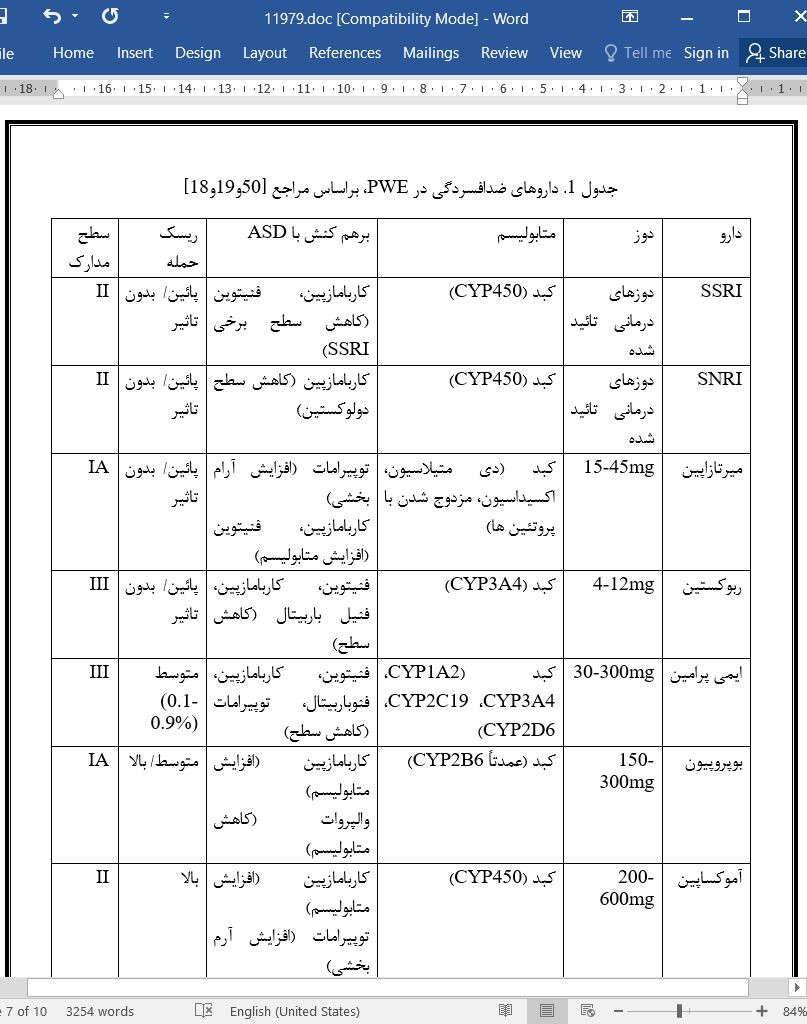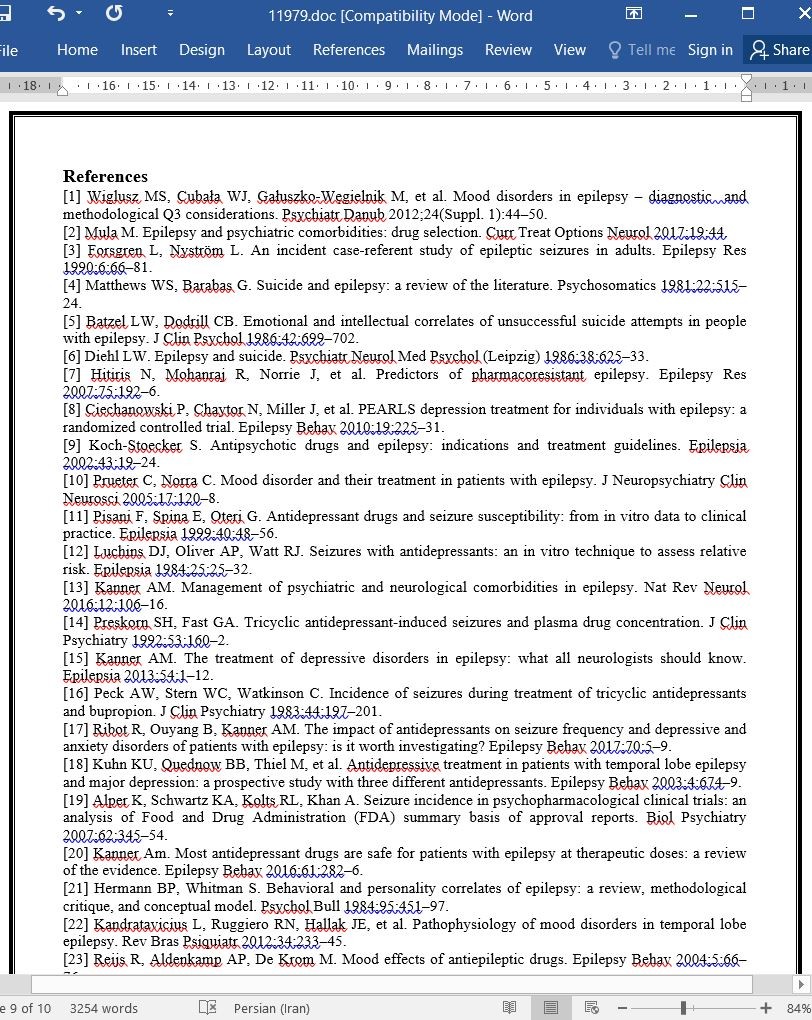
داروهای ضد افسردگی در صرع
چکیده
افراد مبتلا به صرع (PWE) اغلب از اختلالات خلقی همایند و اضطراب رنج می برند. یکی از همایندهای روانپزشکی اصلی که بر کیفیت زندگی افراد مبتلا به صرع تاثیر منفی می گذارد، افسردگی نام دارد. مرور ادبیات نشان می دهد که اکثر حملات ناشی از داروهای ضدافسردگی با دوزهای بسیار بالا یا اوردوز ارتباط داشته اند، و به طور کلی ریسک حملات ناشی از داروهای ضدافسردگی، پائین است. به همان نسبت، مدارکی وجود دارد که نشان می دهد داروهای ضدافسردگی کاربردی ترین گروهها، ریسک حملات را پائین تر می آورد. برای بیماران مبتلا به صرع، چهار داروی ضد افسردگی توصیه نشده است، آموکساپین، بوپروپیون، کلومیپارامین و ماپروتیلین. متخصصین بالینی که از خط اول درمان افسردگی در بیماران مبتلا به صرع استفاده می کنند، باید از SSRI یا SNRI، به ویژه سرترالین، سیتالوپرام، میرتازاپین، ربوکستین، پاروکستین، فلوکستین؛ ستیتالوپرام، فلووکسامین، ونلافاکسن، و دولوکستین استفاده کنند. پیاده سازی داروهای ضد تشنج در بیماران افسرده باید شامل والپروات، کاربامازپین، لاموتریژین، گاباپنتین، و پریگابالین شود. مقاله حاضر مدارک مربوط به استفاده بالینی داروهای ضدافسردگی در PWE را مرور می کند.
1. مقدمه
افراد مبتلا به صرع (PWE) اغلب از اختلالات خلقی همایند رنج می برند. شیوع این بیماری در طول عمر بین 11 و 62 درصد است [1]. یکی از همایندهای روانپزشکی اصلی که تاثیر منفی بر کیفیت زندگی در PWE دارد، افسردگی می باشد [2]. رابطه بین افسردگی و صرع، دوسویه است؛ افسردگی ریسک صرع و صرع ریسک افسردگی را افزایش می دهد [3]. اقدام به خودکشی در میان PWE افسرده، چهار تا پنج برابر نسل عمومی است [6-4]. افسردگی با نرخ بالاتر مقاومت دارویی در PWE نیز ارتباط داشته است [7]. با توجه به این موضوعات، درمان موفق و امن افسردگی ناشی از صرع، از اهمیت بالینی بسزایی برخوردار است.
Abstract
People with epilepsy (PWE) frequently suffer from comorbid mood and anxiety disorders. Depression is one of the major psychiatric comorbidities having a negative impact on the quality of life in people with epilepsy. A review of the literature indicates that the majority of antidepressant-related seizures have been associated with either ultra-high doses or overdosing and, generally, the risk of antidepressant-associated seizures is low. Correspondingly, there is some evidence indicating that antidepressants of most widely used groups may additionally lower the risk of triggering seizures. Four antidepressants are not recommended for patients with epilepsy, i.e.: amoxapine, bupropion, clomipramine and maprotiline. Clinicians applying first line of depression treatment in patients with epilepsy should consider use of SSRIs or SNRIs, particularly sertraline, citalopram, mirtazapine, reboxetine, paroxetine, fluoxetine, escitalopram, fluvoxamine, venlafaxine, duloxetine. Implementation of anticonvulsive drugs in depressed patients should include valproate, carbamazepine, lamotrigine, gabapentin, pregabalin. The paper reviews the evidence for the clinical use of antidepressants in PWE.
1. Introduction
People with epilepsy (PWE) frequently suffer from comorbid mood disorders. Lifetime prevalence ranges between 11% and 62% [1]. One of the major psychiatric comorbidities having a negative impact on the quality of life in PWE is depression [2]. The relationship between depression and epilepsy may be bidirectional; having depression would increase the risk of epilepsy, and having epilepsy appears to increase the risk of depression [3]. Suicide attempts among depressed PWE are four- to fivefold more frequent than in the general population [4–6]. Depression has also been associated with higher rates of drug resistance in PWE [7]. Considering these issues the successful and safe treatment of depression associated with epilepsy is of utmost clinical importance.
چکیده
1. مقدمه
2. داروهای ضدافسردگی- تاثیر بر رخداد حملات
3. ADT- مکانیسم عمل و شیوع حملات
4. برهم کنش بین داروهای ضدافسردگی و AED
5. ADT در صرع
1. 5. ADT در صرع لوب تمپورال (گیجگاهی)
6. نتیجه گیری
منابع
Abstract
1. Introduction
2. Antidepressants – the impact on the occurrence of seizures
3. ADT – mechanism of action and the incidence of seizures
4. Interaction between antidepressant drugs and AEDs
5. ADT in epilepsy
5.1. ADT in temporal lobe epilepsy
6. Conclusion
Conflict of interest
Acknowledgement and financial support
References
- اصل مقاله انگلیسی با فرمت ورد (word) با قابلیت ویرایش
- ترجمه فارسی مقاله با فرمت ورد (word) با قابلیت ویرایش، بدون آرم سایت ای ترجمه
- ترجمه فارسی مقاله با فرمت pdf، بدون آرم سایت ای ترجمه



